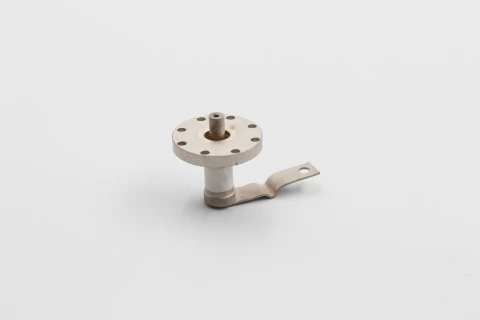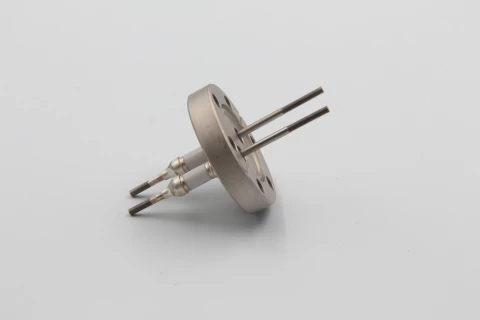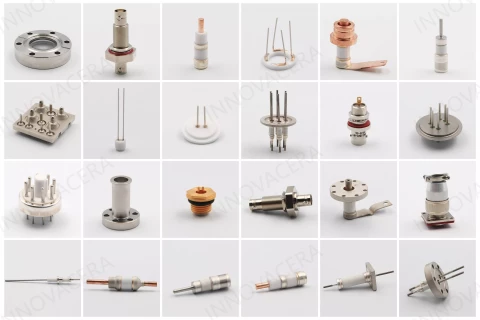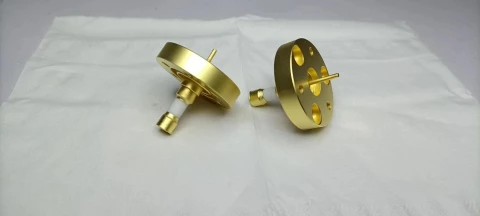Fiber Optic Feedthroughs
Description
Innovacera’s Ceramic-to-Metal Feedthrough Assemblies are precision-engineered components designed for demanding environments requiring hermetic seals, electrical insulation, and mechanical stability. These assemblies utilize advanced brazing techniques to bond ceramics (alumina, sapphire, or glass) to metal components, forming robust seals ideal for high-vacuum, cryogenic, or high-pressure applications.
Commonly integrated in CO₂ laser equipment and scientific instrumentation, these feedthroughs consist of vacuum sealing flanges, oxygen-free copper conductive rods, and high-purity ceramic or glass insulators. They provide excellent thermal and electrical insulation while maintaining structural integrity under extreme conditions.
Each feedthrough is engineered for reliable performance and is available in various configurations, including single-pin, multi-pin, coaxial, and custom electrode designs. Whether for power delivery, signal transmission, or optical access, Innovacera’s ceramic-to-metal solutions ensure low leakage, high dielectric strength, and long-term reliability.
These components are ideal for high-tech sectors such as aerospace, semiconductors, nuclear research, and laser systems. Customization is available to match specific dimensional, electrical, and environmental requirements.
Fiber Optic Feedthroughs
Specifications |
|
|---|---|
| Configuration Options: | Single-pin, Multi-pin, Coaxial, Custom |
| Operating Temperature: | -196 to +250 °C |
| Pressure Rating: | Up to 10⁻⁹ Torr (vacuum) / Up to 300 psi (pressure) |
| Dielectric Strength: | ≥10 kV/mm |
| Leak Rate: | ≤1×10⁻¹⁰ Pa·m³/s |
| Insulation Resistance: | ≥10⁹ Ω at 500 VDC |
| Connector Types: | Flanged, Threaded, Welded |
| Application Compatibility: | CO₂ lasers, UHV systems, cryogenic devices, diagnostics |
| Customization: | Available for pin count, flange type, material, shape |
Features
- Hermetic Sealing: Ensures zero gas leakage in vacuum and pressure systems
- High Dielectric Strength: Excellent electrical insulation via ceramic insulators
- Thermal Stability: Operates across a wide temperature range
- Versatile Configurations: Available in single-pin, multi-pin, and coaxial formats
- Durable Construction: Oxygen-free copper and high-purity ceramic materials
- Laser-Compatible: Widely used in CO₂ and other high-power laser systems
- Corrosion-Resistant: Ideal for reactive gas or harsh chemical environments
- Custom Engineering: Tailored dimensions, pin counts, and sealing types
Applications
- CO₂ Laser Equipment: Reliable interface for vacuum-sealed laser components
- Vacuum Chambers: Sealed electrical feedthroughs for UHV environments
- Cryogenic Systems: Maintains integrity at extremely low temperatures
- Semiconductor Equipment: Contamination-free power and signal interfaces
- High-Voltage Insulation: Electrically isolates systems at high potentials
- Scientific Research: Vacuum and pressure setups in labs and institutes
For pricing, technical or any other questions please contact the supplier
- No registration required
- No markups, no fees
- Direct contact with supplier
-
Ships from:
China
-
Sold by:
-
On FindLight:
since 2020
Frequently Asked Questions
Ceramic-to-metal feedthroughs provide a hermetic, electrically insulated interface between different environments—such as the interior of a vacuum chamber and external electrical systems. They allow for the secure passage of electrical signals or power without compromising vacuum integrity or insulation properties.
These feedthroughs commonly use alumina ceramics for insulation due to its high dielectric strength and thermal stability. Metals like oxygen-free copper, Kovar, and stainless steel are used for the conductive and structural elements. These materials are brazed together to form a hermetically sealed component.
Innovacera’s feedthroughs are precision-engineered using advanced brazing techniques to ensure leak rates as low as 1×10⁻¹⁰ Pa·m³/s. The high-purity ceramic and metallization process provide excellent vacuum compatibility, corrosion resistance, and electrical insulation under extreme conditions.
Yes, Innovacera offers full customization options including pin configurations, flange types, ceramic grades, material choices, and size dimensions. This allows the components to be tailored for applications ranging from CO₂ lasers and cryogenics to semiconductor and nuclear research.
These assemblies are designed to operate reliably from -196°C to +250°C and can withstand vacuum levels down to 10⁻⁹ Torr and pressure conditions up to 300 psi, depending on the configuration and materials used.




